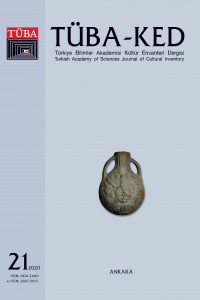Abstract
İstanbul’un günümüze ulaşan en önemli antik yapılarından biri Myrelaion Rotondası’dır. Gerek ‘rotonda’ şeklindeki özgün mimari formu gerekse tarihsel süreçte değişimler gösteren mimari ve işlevsel özellikleriyle İstanbul’un kadim tarihinde özel bir yere sahiptir. Konuya ilişkin yapılan bilimsel çalışmalarda; yapının ilk inşa edildiği döneme ve bu dönemdeki niteliğine yönelik farklı değerlendirmelerin olduğu anlaşılmaktadır. Bu çalışma ile antik Rotonda yapının tarihsel süreci ve bu süreçteki fiziki değişimleri ele alınarak yapının özelliklerine dair kapsamlı bir araştırmanın ortaya konulması hedeflenmiş, yapının ilk inşa edildiği dönem ve o dönemdeki işlevine dair değerlendirmelerde bulunulmuştur. Rotonda yapının güncel durumuna ilişkin ise yakın tarihteki niteliksel değişimleri, çevresel ölçekte fiziki durumu, kent dokusuyla ilişkisi ve korunmasına yönelik yapılan girişimler, kentsel arkeoloji bağlamında incelenerek yapının güncel durumunun kültürel mirasın korunması çerçevesinde iyileştirilmesi ve kentin güncel yaşam dokusuyla bütünleşmesine dair tespit ve önerilerde bulunulmuştur.
References
- ALTUĞ, K., 2017, “Myrelaion Rotundası”, Toplumsal Tarih, 280, İstanbul, s. 12-16.
- AKARCA, A., 1998, Şehir ve Savunması, Türk Tarih Kurumu Basımevi, Ankara.
- AYDENİZ, N., E., 2009, “Kent Arkeolojisi Kavramının Dünyadaki Gelişimi ve Türkiye’deki Yansımaları” Journal of Yaşar University, 4(16), s. 2501-2523.
- AYDOĞDU, Y., 2011, Kentsel Arkeoloji Koruma Alanlarının Yönetimi İstanbul Yenikapı Örneği, Yıldız Teknik Üniversitesi fen Bilimleri Enstitüsü Şehir ve Bölge Planlama Bölümü (Yüksek Lisans Tezi) İstanbul, (Erişim: YÖK Ulusal Tez Merkezi, Tez No:297022.)
- BAŞGELEN, N., 2016, İstanbul’da Marmaray-Metro Kazılarının Kent Arkeolojisine Katkıları, Arkeopera, İstanbul.
- BAŞGELEN, N., 2007, İstanbul Tarihi Yarımada ve Arkeoloji 1860-1960, Arkeoloji ve Sanat Yayınları, İstanbul.
- BELGE, B., 2004, “Çok Katmanlı tarihi Kent Merkezlerinin Yönetimi; Kentsel Arkeoloji ve Planlama”, TMMOB Şehir Plan- cıları Odası Planlama Dergisi, 4, s. 48-56.
- SALTUK, S., 1993, Arkeoloji Sözlüğü, İnkılap, İstanbul.
- SARFATİJ, H., MELLİ, P., 1999, “Archaeology and The Town”, Reporton the Situation of Urban Archaeology in Europe, p. 13-29, Council Of Europe Publishing, Germany.
- FREELY, J., ÇAKMAK, A.S., 2005, İstanbul’un Bizans Anıtları, Çev. Gülru Tanman, YKY, İstanbul.
- FRENCH, D., 1966, “Recent Archaeological Research İn Turkey- Myrelaion (İstanbul)”, Anatolian Studies, 16, p. 26-53.
- FRENCH, D., 1967, “Recent Archaeological Research İn Turkey- Myrelaion (İstanbul)”, Anatolian Studies, 17, p. 30-31.
- GÖKÇAY, M., 2007, “İstanbul Kent Arkeolojisi” Mimarist 7, 24, Haziran, s. 89-93.
- KIZILTAN, Z., 2014, Marmaray-Metro Projesi Kurtarma Kazıları: Yenikapı Sirkeci ve Üsküdar İstasyonları Arkeoloji Çalışmaları ve İstanbul’un Sekiz Bin Yılı, Gama Holding, Ankara, s. 54-83.
- KUTLUAY, A., 2016, Constantinople in the Early Fifth Century: The No- titia Urbis Constantinopolitanae, Daily Life, and an Archaeological Perspective, Koç Üniversitesi Sosyal ve Beşeri Bilimler Enstitüsü (Yayımlanmamış Yüksek Lisans Tezi), İstanbul.
- MÜLLER-WİENER, W., 2001, İstanbul’un Tarihi Topografyası, YKY, İstanbul.
- NAUMANN, R., 1966, “Bodrum Camii (Myrelaion) Kazısı”, İstanbul Arkeoloji Müzeleri Yıllığı, 13-14, İstanbul, s. 64-67.
- NAUMANN, R., 1966, “Der antike Rundbau beim Myrelaion un der Palast Ro- manos I Lekapenos”, İstanbuler Mıtteılungen, 16, DAİ, p. 199-216.
- NİEWÖHNER, P. 2010, “Der frühbyzantinische Rundbau beim Myrelaion in Kostantinopel Kapitelle, Mosaiken und Ziegelstempel”, İstanbuler Mıtteılungen, 60, DAİ, p. 411-459.
- ORTAYLI, İ., 1994, “Langa”: Dünden Bugüne İstanbul Ansiklopedisi, C. 5, s. 195-196.
- RAYMOND, J., 1968, “Janin Notes d’Histoire et de topographie. In: Revue des études byzantines”, Tome, 26, p. 171-184.
- RAYMOND, J., 1939, “La topographie de Constantinople byzantine Etudes et decouvertes (1918-1938) In: Échos d’Orient” Tome, 38, p. 118-150.
- STRZYGOWSKİ J., FORCHHEIMER P., 1893, Byzantinischen Wasserbehälter von Konstantino- pel. Beiträge zur Geschichte der Byzantinischen Ba- ukunst und zur Topographie von Konstantinopel, Druck und Verlag der Mechitharisten-Congregation, Wien.
- TDV İSLAM ANSİKLOPEDİSİ 1992, “Bodrum Cami” C. 6, İstanbul, s. 250.
- TUNA, N., 2000, “Kentsel Arkeoloji Üzerine”, Arkeoloji ve Arkeologlar Derneği Dergisi İdol, 7, s. 7-13.
- WULZINGER, K. 1925 Byzantinische Baudenkmäler zu Konstantinopel : auf der Seraispitze, die Nea, das Tekfur-Serai und das Zisternen Problem, Heinz Lafaire, Hannover.
Details
| Primary Language | Turkish |
|---|---|
| Subjects | Cultural Studies |
| Journal Section | Research Articles |
| Authors | |
| Publication Date | September 17, 2020 |
| Submission Date | November 1, 2019 |
| Published in Issue | Year 2020 Issue: 21 |
Publisher
Vedat Dalokay Caddesi No: 112 Çankaya 06670 ANKARA
TÜBA-KED Turkish Academy of Sciences Journal of Cultural Inventory (TÜBA-KED) does not officially endorse the views expressed in the articles published in the journal, nor does it guarantee any product or service advertisements that may appear in the print or online versions. The scientific and legal responsibility for the published articles belongs solely to the authors.
Images, figures, tables, and other materials submitted with manuscripts must be original. If previously published, written permission from the copyright holder must be provided for reproduction in both print and online versions. Authors retain the copyright of their works; however, upon publication in the journal, the economic rights and rights of public communication -including adaptation, reproduction, representation, printing, publishing, and distribution rights- are transferred to the Turkish Academy of Sciences (TÜBA), the publisher of the journal. Copyright of all published content (text and visual materials) belongs to the journal in terms of usage and distribution. No payment is made to the authors under the name of copyright or any other title, and no article processing charges are requested. However, the cost of reprints, if requested, is the responsibility of the authors.
In order to promote global open access to scientific knowledge and research, TÜBA allows all content published online (unless otherwise stated) to be freely used by readers, researchers, and institutions. Such use (including linking, downloading, distribution, printing, copying, or reproduction in any medium) is permitted under the Creative Commons Attribution-NonCommercial-NoDerivatives 4.0 International (CC BY-NC-ND 4.0) License, provided that the original work is properly cited, not modified, and not used for commercial purposes. For permission regarding commercial use, please contact the publisher.

